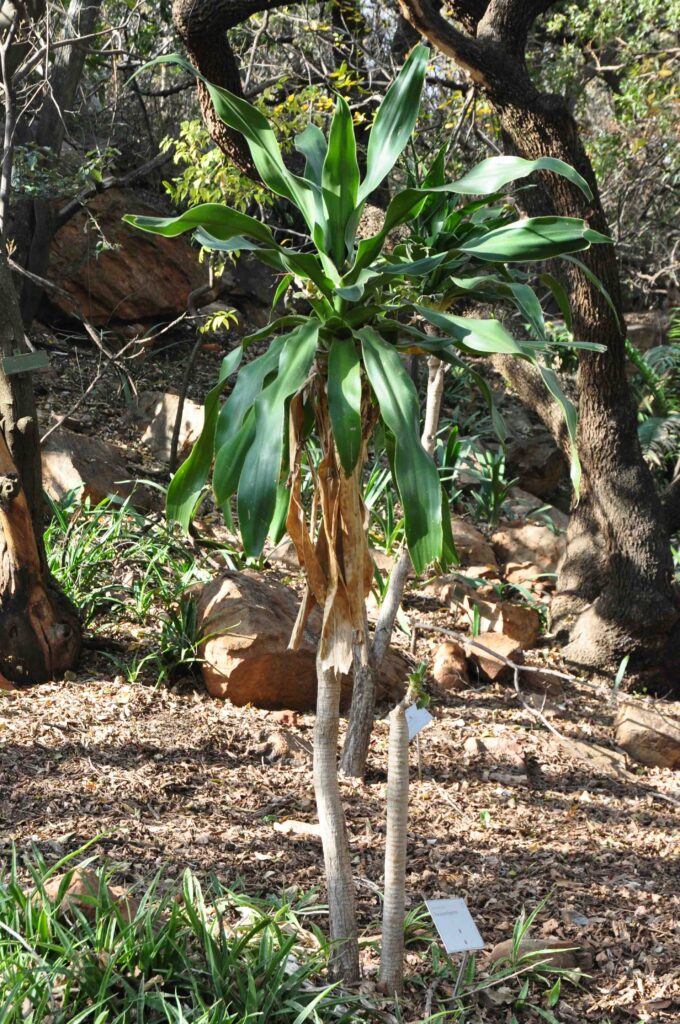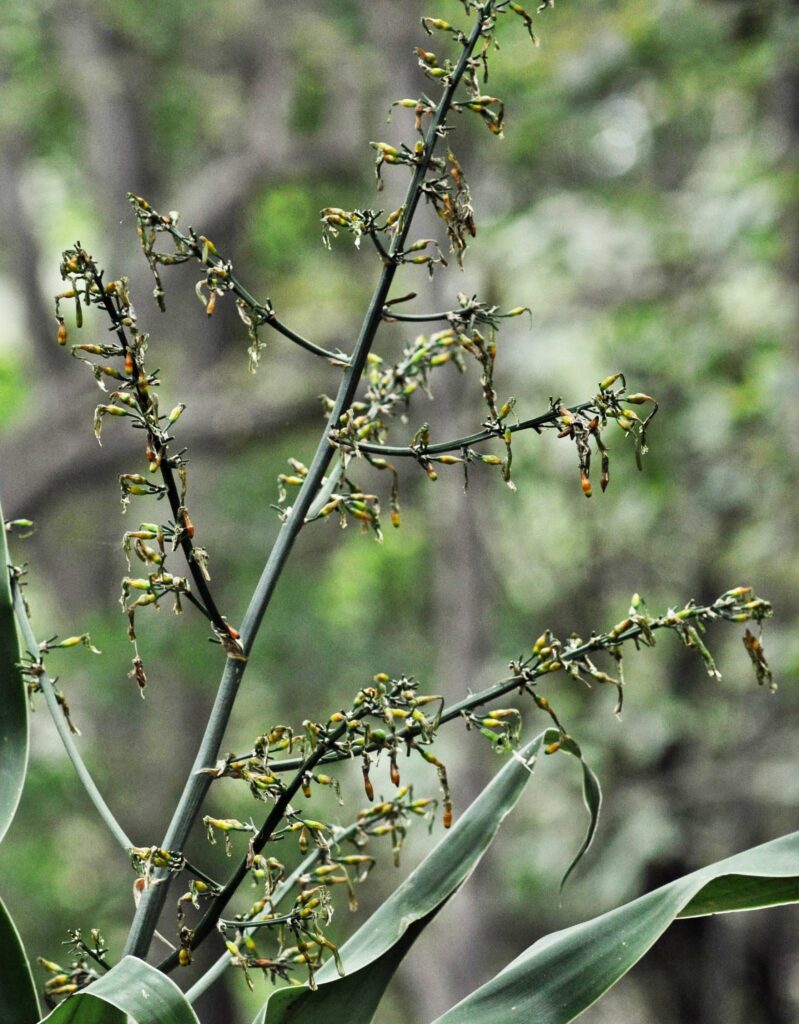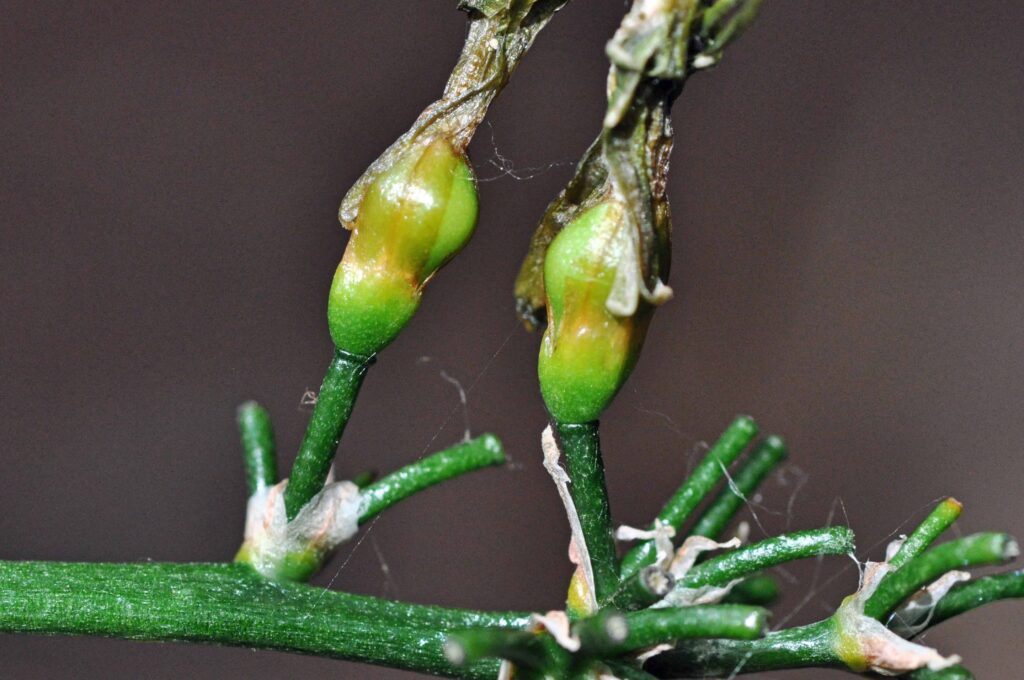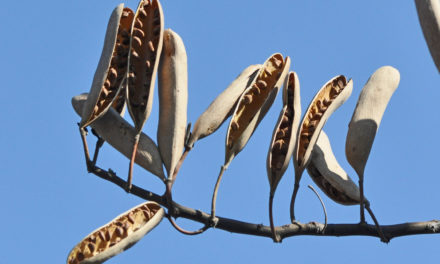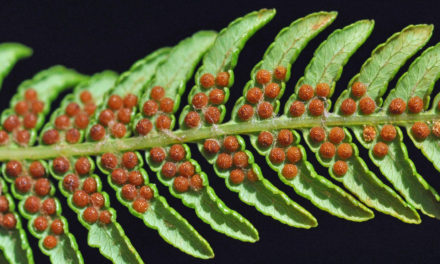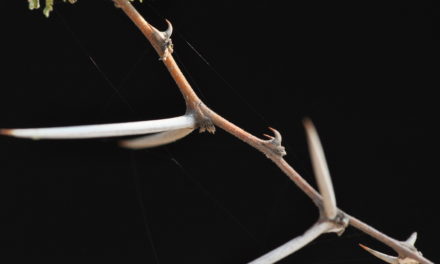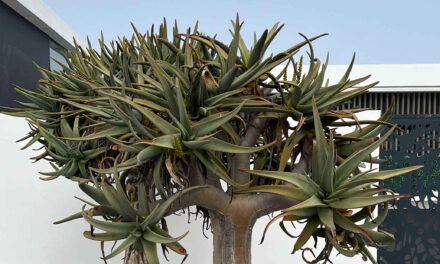General Info – summary
This Tree is usually less than 15m high with a narrow stem & occurs in moist frost-free forests away from the sea. Bark is silver-green and smooth. Strap shaped Leaves at branch ends have parallel veins + amplexicaul base. Insect pollinated Flowers in long, erect terminal panicles, each with 6 tepals & 6 stamens surrounding the superior, trilocular ovary. Ripe Fruit is a stalked, orange-red berry with 1 or more dull white seed/s.
Dracaena fragrans
SA Tree No. n/a
Common names: Afr. Kleindrakeboom. Eng. Compact Dracaena, Cornstalk dracaena, Corn plant, Forest dracaena, Small dragon Tree, Striped dracaena.
Family Asparagaceae (asparagus family). Previous family names include Dracaenaceae and Liliaceae. This family includes about 120 genera and in excess of 2 000 species. Members of Asparagaceae are united primarily by genetic and evolutionary relationships rather than morphological similarities.
Name derivation: Dracaena – a female dragon or named after Sir Francis Drake an English explorer who circumnavigated the world in 1577 and 1580. “Dragon’s blood” is a bright red resin obtainable from some plant species including species of Croton, Dracaena, Pterocarpus and others. fragrans – fragrant flowers. Many varieties of this species are available.
Conservation Status: No problem.
Description
Tree
The Tree usually ranges from 1,5 to 15m, is usually a slow growing unbranched shrub and may be multi-stemmed from the base. Young Stems are silver-green and smooth. They usually have a single unbranched stem but may be multi-stemmed at the base. These additional stems are more common in non-vertical reclining stems. In older plants, the stem may reach 30cm in diameter. Flowering and physical damaging, both enhance branch development.
- 350. 2017/08/03 Pretoria NBG. Photo: David Becking.
Leaves
The broadly strap-shaped Leaves are spirally, arranged, smooth, glossy green, have parallel veins and develop at stem ends (photo 350) They are entire (with a continuous margin, not in any way indented but may be hairy) and much longer than wide (0,2 x 1m). The base of the evergreen leaves is Amplexicaul (having an enlarged base that encircles the stem). The leaves form a rosette at the apex of young stems. After flowering, the plant tends to produce 2 branches and continues to do so after each flowering episode. Damage has the same effect. Young leaves tend to point upwards and droop as they age (photo 350 under Tree). In this photo the light brown old leaves shrink, hang down and soon fall.
Flowers
The star-shaped Flowers are produced in terminal Panicles (indeterminate, branched inflorescence with stalked flowers) – up to 150cm long. Each flower is up to 2,5cm wide and is whitish to purple, bisexual and opens in the early evening. There are 6 initially pink Tepals (one of the parts of the perianth when these parts cannot easily be divided into calyx and corolla) that are petal-like and initially tubular. Opened lobes are white, about 0,2cm long and have a central line that is purple or red. There are 6 Stamens with Anthers that are versatile (hung or attached near the middle, usually moving freely) and introrse (an anther whose line of dehiscence faces towards the center of the flower). Each flower has a superior, trilocular Ovary with a slender Style and a Stigma that is capitate (formed like a head). Flowers are similar to those of the Liliaceae. A highly fragrant scent attracts mainly insect pollinators.
- 403. 2017/08/03 Pretoria NBG. Photo: David Becking.
Fruit
The ripe, orange-red Fruit is a Berry (pulpy, indehiscent fruit like a grape or tomato) which is up to 2cm in diameter. A stalk-like obconical (resembles an inverted cone) receptacle (the expanded tip of the flower stalk the pedicel (photo 405), from which the floral parts develop. It is greatly expanded in the Asteraceae and Ficus) and is persistent in fruit. The fruit is lobed when more than 1 Seed is present. Seeds are a dull white.
- 405. 2018/01/06 Pretoria NBG. Photo: David Becking.
Distribution & Ecology
Dracaena fragrans are common slow growing understory mountain plants where they may form extensive masses. They are found from Zimbabwe e.g., Chirinda Forest Nature Reserve and the Bvumba Mountains – both in the Zimbabwe eastern highlands (impressive places to visit), and the western highlands of Mozambique. These plants also occur in the Gorongosa Forest. Mount Gorongoza (is the highest peak of Mount Gogogo – at an altitude of 1 863m. It is about 180km (map distance) northwest of Beira. Central Mozambique is in the southern end of the Great African Rift Valley that extends northwards from Zimbabwe. through Malawi, Tanzania, Zambia, Burundi, Rawanda, Congo DR and Kenya. The plants also occur northwards to Sudan, westwards to Angola and north-west to the Ivory Coast, usually at an altitude range of 600 – 2 200m. They are frost sensitive and grow well in shady areas – often close to streams. The flowers attract many insects. Hummingbirds may visit the flowers. Swynnerton’s Robin is an extremely rare bird with relatively large eyes. These birds stay relatively close to the ground and build their nests almost exclusively among the leaves of Dracaena fragrans. The distribution of this rare bird in Mozambique is thus closely linked to the forests where this plant occurs in large numbers (e.g., the upper parts of Mount Gorongoza).
Ethnobotany
Dracaena fragrans plants are often planted as a hedge plant. Due to its ability to flourish on reduced sunlight, their leaf composition allows them to photosynthesis well in household light making it a good indoor plant. NASA (National Aeronautics and Space Administration) found that this plant reduces the following air pollutants: benzene, formaldehyde and trichloroethylene but the plant leaves are toxic to dogs and cats. They contain saponins, which usually do not harm humans but can kill fish. Grow the plant from cuttings – about as long as your hand. Do not use water with a high level of fluoride and avoid superphosphates. Remember that they grow well in shade. This low-maintenance plant is often grown as a houseplant. Symptoms of insufficient water include brown leaf tips. These house plant seldom flowers – due to insufficient light. Beyond their natural home, these plants may be grown as a hedge and do best in a frost-free environment.
References
Burrows, J.E., Burrows, S.M., Lotter, M.C. & Schmidt, E. 2018. Trees and Shrubs Mozambique. Publishing Print Matters (Pty) Ltd. Noordhoek, Cape Town.
Gin, P.J. McIlleron, W. G. and Milstein, P. Le S. 1989. The Complete Book of Southern African Birds, Struik, Cape Town.
Lawrence, G. H. M, 1951. Taxonomy of Vascular Plants, The Macmillan Company, New York. Tenth Printing 1965.
https://en.wikipedia.org/wiki/NASA_Clean_Air_Study#cite_note-ASPCA-23
https://www.hunker.com/13428246/dracaena-plant-toxicity
http://posa.sanbi.org/flora/browse.php?src=SP
https://en.wikipedia.org/wiki/Dracaena_fragrans
https://plants.ces.ncsu.edu/plants/dracaena-fragrans/
https://www.zimbabweflora.co.zw/speciesdata/species.php?species_id=114620

